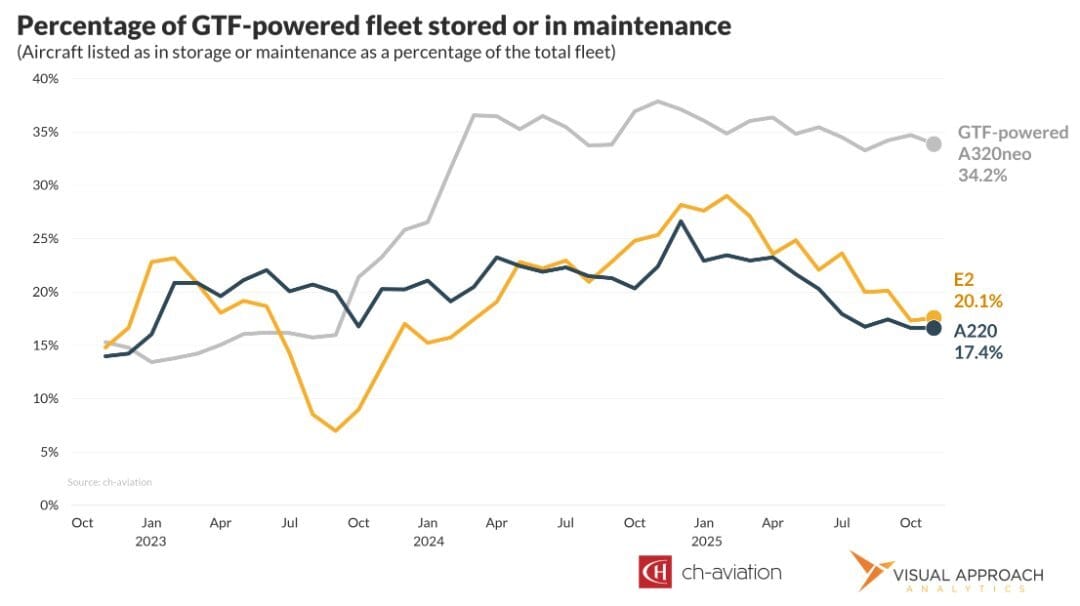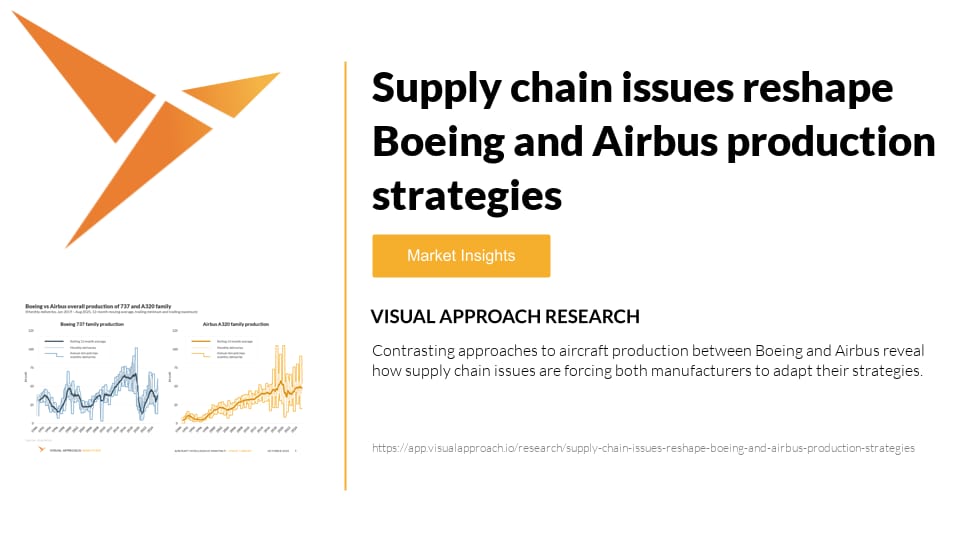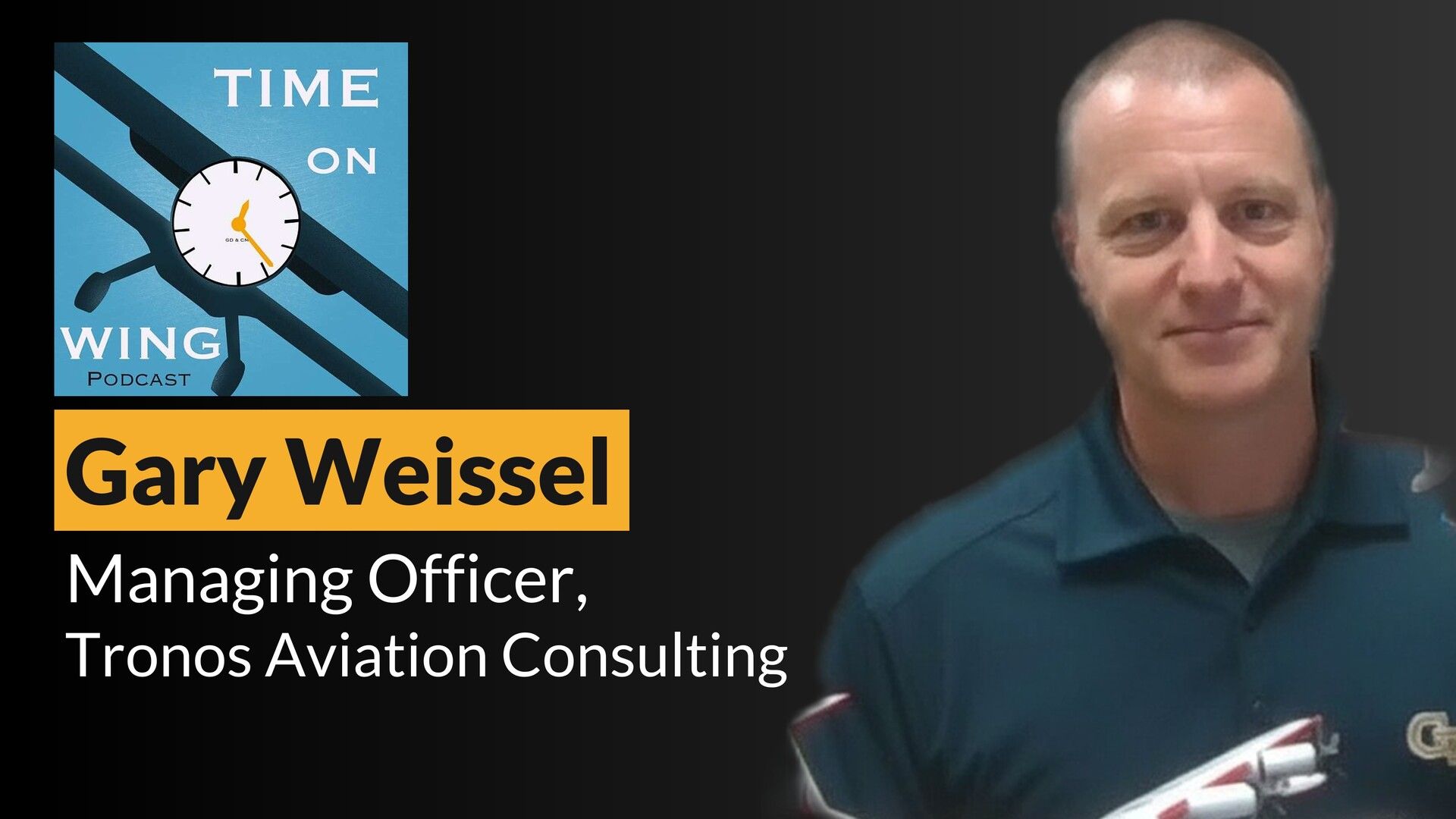- Aviation's Week in Charts
- Posts
- A220 and E2 seeing reduced impact to GTF - it's still not great
A220 and E2 seeing reduced impact to GTF - it's still not great
A320neo continues to dominate the parked rates of GTF-powered aircraft

Frustration is mounting for airlines operating GTF-powered aircraft.
To be fair, frustration has already mounted, but it continues to mount.
The contaminated powdered metal in the high-pressure turbine disk of the GTF engine has created a fleet of unavailable aircraft. The approved solution to prevent a catastrophic failure of the disk was to place cycle limits on the contaminated parts before they were required to undergo inspection.
Those limits arrived. Airplanes were parked.
The contaminated powdered metal impacted the PW1100G engines on the A320neo family, the PW1500G mounted on the A220 family, and the PW1900G mounted on Embraer’s E2. While the lower-thrust A220 and E2 saw longer limits due to lower overall pressures, the limits still arrived.
Operators have long complained of 300-day lead times to return their inspected aircraft to service. That 300-day lead time includes one day for the inspection. The remaining 299 days include disassembly of the engine to gain access to the parts, repairs for any wear discovered during the disassembly, and reassembly. It also includes a significant wait for the MRO capacity to start the disassembly.
The point is, 300 days from when the airplane can’t fly until it can again… assuming both engines go through at the same time. Oh, and the vast majority of the parts are passing inspection, so they are sent back into the engine with a new limit ticking until the process must be repeated, this time with a replacement rather than an inspection. Another 299 days.
No bueno.
This incredibly disruptive situation for GTF operators brings said mounted frustration. Entire fleets are parked, awaiting MRO capacity to access the parts for inspection, only to be reinstalled after passing.
As can be expected, some operators are triaging their GTF fleets, parking smaller aircraft to ensure engines are available for the larger. This has happened with A320neos for years (yes, we’re at the point where we can start referring to this problem in terms of years).
Already, the industry has seen A321neo and A220 aircraft parted out for those sweet, sweet engines. Why? Does this mean the aircraft are no longer wanted and are worth more as scrap aluminum (or aluminium for those revisionists who feel the need to change it from its original spelling)?
It means the two engines hanging from those A321neo and A220 aircraft are worth more to large airlines by keeping another aircraft operating. (Think of it like a billionaire who needs a donor kidney. What would they be willing to pay for one of yours? Also, that billionaire needs both.)
But the GTF problem is not proportionally spread across the fleet. The GTF-powered A320neo fleet remains on the ground at almost twice the rate of the E2 and A220. As of November 2025, 34% of the GTF-powered A320neo fleet remains in storage or maintenance. (This 34% includes aircraft parked for all reasons, not just the GTF inspection issue, but it remains the primary reason for the elevation in parked aircraft.)
Compare this 34% of the inactive GTF-powered NEO fleet with 20% and 17% of E2s and A220s currently inactive. Now consider how little consolation that provides to A220 and E2 operators with inactive aircraft.
Swiss International Air Lines announced last month that it will park all nine of its A220-100s to ensure engine availability for its larger fleet of 21 A220-300s. That SWISS will park nine airplanes to keep 21 flying is painful. 30% of SWISS’s fleet will be on the ground.
That’s much higher than the 17% fleet average, but still lower than the 34% average GTF-powered NEO fleet (SWISS was the launch operator for the CS100, making these renamed A220-100s the oldest in the fleet).
The result appears to be a disconnect in context, with an “entire” fleet of A220-100s being parked to support other aircraft, and yet the A220 remains the least impacted across all GTF-powered aircraft.
That the A220 is below the E2 came as a surprise to us, since far more A220s were manufactured during the period when the contaminated metal was used. However, we attribute this difference to the ebbs and flows of normal aircraft seasonality and movement.
Regardless, this is not a great situation. For those who skip to the end (or even bother to make it this far), consider the grand, unstated conclusion in all of this: The GTF problems for the A320neo are not getting better anywhere near the rates originally expected.
Which leads to the next problem we’re focused on with our research clients. What happens when they come back?
Research published this week
Gary Weissel talks supply chain challenges
The most recent conversation on the Time on Wing Podcast includes Gary Weissel of Tronos Aviation Consulting. Gary is the expert on aircraft reconfiguration, and as such, is close to the supply chain challenges that are impacting the industry today.
You can listen to the podcast, or watch it on YouTube.

You should do a chart on…

AI-generated chart that shows… nothing
We like to create valuable charts. But, it’s not easy coming up with new ideas amid the endless hours delivering data-driven edge to our customers. In our quest to provide a valuable weekly newsletter we can keep guessing what you find most valuable, or you could just tell us.
If you have an idea for data visualization, reply to this email and let us know what analysis you’d find most valuable. We’d love to hear from you and will happily name-drop.
ACCESS OUR DATA AND ANALYSIS
We provide bespoke analysis to investors, lessors, and airlines looking for an edge in the market.
Our approach to analysis is data-driven and contrarian, seeking perspectives to lead the market, question consensus, and find emerging trends.
If a whole new approach to analysis could provide value to your organization, let's chat.
If you were forwarded this email, score!
As valuable as it is, don't worry; it's entirely free. If you would like to receive analyses like this regularly, subscribe below.
Then...
You can pay it forward by sending it to your colleagues. They gain valuable insights, and you get credit for finding new ideas!
Win-win!
Contact us
Have a question? Want to showcase your organization in a sponsored analysis? Reach out.
It’s easy. Just reply to this email.
Or, if you prefer the old way of clicking a link, we can help with the hard part: contact

